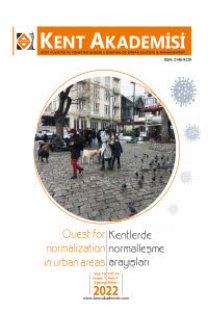Mimari Estetik Değerlendirme ve Kapsayıcı Sanal Gerçeklik
Mimari, sanal gerçeklik, sürükleyici, estetik, takdir, katılım
Immersive Virtual Reality IVR, and The Appreciatıon of Architectural Aesthetics
Architecture, virtual reality, immersive, aesthetics, appreciation, engagement,
___
- Abdulhameed, W. (2013). Virtual Reality Use in Architectural Design Studios: A Case of Studying Structure and Construction. Procedia Computer Science (25), 220 – 230.
- Achten, H. (2022). A concise history of vr/ar in architecture. İn Eloy, S., Kreutzberg, A., & Symeonidou, I. Eds. (2022). Virtual aesthetics in architecture. New York, Routledge, 3-9.
- Aitamurt T., Boin, J., Chen, K., Cherif, A., & Shridhar, S. (2018). The Impact of Augmented Reality on Art Engagement: Liking, Impression of Learning, and Distraction. In J. Y. C. Chen & G. Fragomeni (Eds.): VAMR 2018, LNCS 10910, pp. 153–171. https://doi.org/10.1007/978-3-319-91584-5_13.
- Antomarini, B. & Berg, A. Eds. (2013). Aesthetics in Present Future: The Arts and the Technological Horizon. Maryland, Lexington Books.
- Aydin, S. & Aktaş, B. (2020). Developing an Integrated VR Infrastructure in Architectural Design Education. Frontier Robotics and AI, 22 October 2020. https://doi.org/10.3389/frobt.2020.495468.
- Bartlem, Edwina (2005). Reshaping Spectatorship: Immersive and Distributed Aesthetics. Fibreculture Journal: Distributed Aesthetics, 7.
- Bates, J. (1992). Virtual Reality, art and entertainment. Presence: Tele operators & Virtual Environments, 1, 133-138.
- Berleant, A. & Carlson, A. (2007). The Aesthetics of Human Environments. Toronto, Broadview Press.
- Berleant, Arnold (2013). Aesthetic Engagement. Contemporary Aesthetics, (11), 2. www.contempaesthetics.org.
- Bowman, D. A. & McMahan R. P. (2007). Virtual Reality: How Much Immersion Is Enough? Computer, vol. 40 (7) 36-43. Doi: 10.1109/MC.2007.257.
- Bruder, G., Steinicke, F., & Hinrichs K. H. (2009). Arch-Explore: A Natural User Interface for Immersive Architectural Walkthroughs. Proceedings of IEEE Symposium on 3D User Interfaces (3DUI), 75–82.
- Chen J. & Fragomeni, G., Eds (2018). Virtual, Augmented and Mixed Reality Applications in Health, Cultural Heritage, and Industry. 10th International Conference, VAMR 2018, Held as Part of HCI International 2018, Las Vegas, NV, USA, July 15–20, 2018.
- Dieck, M., Jung, T., & Loureiro, S., eds. (2021). Augmented Reality and Virtual Reality. Switzerland, Springer Nature Switzerland AG, Progress in IS.
- Eloy, S., Kreutzberg, A., & Symeonidou, I. Eds. (2022). Virtual aesthetics in architecture. New York, Routledge.
- Grazuleviciute-Vileniske I., Viliunas G. & Daugelaite A. (2021). The role of aesthetics in building sustainability assessment. SPATIUM, 45, 79-89. https://doi.org/10.2298/SPAT2145079G.
- Hubbard, P. (1996). Conflicting Interpretations of Architecture: An Empirical Investigation. Journal of Environmental Psychology, 16(02), 75-92.
- Jennatha, A., & Nidhish, P. (2016). Aesthetic Judgement and Visual Impact of Architectural Forms: A Study of Library Buildings. Procedia Technology, (24) 1808 – 1818.
- Kim, B. (2016). Virtual Reality as an Artistic Medium: A Study on Creative Projects Using Contemporary Head-Mounted Displays. MA Dissertation, Aalto University, Media.
- Kim, J. & Kim, S. (2019). Finding the Optimal D/H Ratio for an Enclosed Urban Square: Testing an Urban Design Principle Using Immersive Virtual Reality Simulation Techniques. International Journal of Environmental Research and Public Health,16(865), Doi:10.3390/ijerph16050865.
- Kinzler, H., Zolotareva D., & Tadauchi R. (2022). Cybernetic aesthetics. İn Eloy, S., Kreutzberg, A., & Symeonidou, I. Eds. (2022). Virtual aesthetics in architecture. New York, Routledge, 21-33.
- Krinizki, K., Gisbergen, M., Rashnoodi, S., & Grinten, T. (2021). A Matter of Perception: Investigating the Effect of Virtual Reality on Spatial Understanding. In Dieck, M., Jung, T., & Loureiro, S., eds. (2021). Augmented Reality and Virtual Reality. Switzerland, Springer Nature Switzerland AG, Progress in IS. 277-290. https://doi.org/10.1007/978-3-030-68086-2_21.
- Kulczak-Dawkins, Richard. (2001). The Aesthetic Experience of Architecture - Debating the essentialist account of Roger Scruton. MA Thesis. University of London.
- Machado S., Souza, A., & Moraes, R. (2004). A concept of low-cost virtual wall for virtual reality systems to educational purposes. World Congress on Engineering and Technology Education WCETE March 14 - 17, São Paulo, BRAZIL, 161-165.
- Mohemed, A (2020). Sonic effects on the appreciation of architectural aesthetics of architectural design projects. The International Journal of Architectonic Spatial and Environmental Design, 14 (4), 21-29. DOI: 10.18848/2325-1662/cgp/v14i04/21-29.
- Paes, D., Arantes, E., & Irizarry, J. (2017). Immersive environment for improving the understanding of architectural 3D models: Comparing user spatial perception between immersive and traditional virtual reality systems. Automation in Construction. 84. 292-303. DOI: 10.1016/j.autcon.2017.09.016.
- Popkonstantinovic, B.; Nikolic, I.; Perisic, A. & Kekeljevic, I. (2011). Fly-through Animation at the Faculty of Technical Sciences in Novi Sad. Facta Universitatis, series Architecture and Civil Engineering, 9,2, 277-287.
- Schipper, D. & Holmes B. (2022). How architects are using immersive technology today, and projections for the future. İn Eloy, S., Kreutzberg, A., & Symeonidou, I. Eds. (2022). Virtual aesthetics in architecture. New York, Routledge, 34-50.
- Seo, J. (2011). Aesthetics of Immersion in Interactive Immersive Installation: Phenomenological Case Study of Light Strings. MA Thesis. Seoul Women’s University.
- Slater, Mel, Lotto, B., Arnold, M., & Sánchez-Vives, M. (2009). “How we experience immersive virtual environments: the concept of presence and its measurement”. Anuario de Psicología, 40, 2, 193-210.
- Spence, C. (2020). Senses of place: architectural design for the multisensory mind. Cogn. Research 5, 46. https://doi.org/10.1186/s41235-020-00243-4.
- Vinchu, G., Jirge, N. & Deshpande, A. (2017). Application of Aesthetics in Architecture and Design. International Journal of Engineering Research and Technology. 10 (1).
- Whyte, Jennifer (2002). Virtual Reality and the Built Environment. Architectural Press. Oxford.
- ISSN: 2146-9229
- Yayın Aralığı: Yılda 4 Sayı
- Başlangıç: 2008
- Yayıncı: Karadeniz Yazarlar ve Şairler Derneği
Yarı Açık Mekânlarda İşitsel Peyzaj Algısının Diyarbakır Ulu Camii Avlusunda Değerlendirilmesi
Beritan OCAKLIK, Derya ÇAKIR AYDIN
Mekân Konfigürasyonun Zeugma Mozaik Müzesinde Mekân Sentaksı Yöntemiyle İncelenmesi
Acil Uzaktan Eğitimde Bir Yapım Tasarımı Deneyimi: Detay Örüntüleri
Hülya Nur KIZILYAPRAK, Berkay OSKAY
Mimari Estetik Değerlendirme ve Kapsayıcı Sanal Gerçeklik
Abdurrahman MOHAMED, Hilal Tuğba ÖRMECİOĞLU
Yeni Yapılaşmalarda Kent Kimliği-Kentsel Bellek İlişkisinin İncelenmesi: Elazığ Örneği
Şeyma SARIŞIN, Berivan ÖZBUDAK AKÇA
Açık Kaynaklı Mimarlık ve Çevresel İyileştirme Potansiyelleri
Mehmet Oğuz DURU, Sevde Gülizar DİNÇER, İlhan KOÇ
Tillo Geleneksel Konutlarının Fiziksel ve Fonksiyonel Kullanımının Değerlendirilmesi
